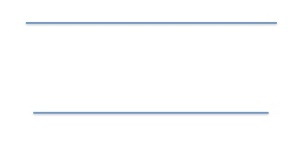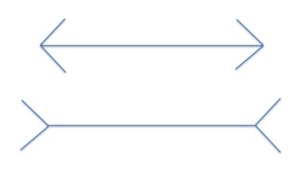Your Expertise Might Be An Illusion
Here’s an old brain trick: Look below. Which line is longer? You know this trick. They are the same, right?
But I changed the trick. Here are the same lines as above but I took the fins off. Look again.
Yes. You see they are different now. Ten percent different.
Maybe you weren’t fooled because you anticipated a trick. But your brain still recognized that old familiar illusion. It’s called the Müller-Lyer illusion. Even when you know it’s a brain trick – a visual illusion – it’s still hard to see it differently. In your mind you know they are the same length because you have learned that the lines are the same, despite what you see.
But visual illusions are different than cognitive illusions. We can mentally adjust to what we think we see, but it’s much harder to adjust or change what we think we know. Cognitive illusions can be more persistent and harder to dispel than visual illusions.
Years ago, the psychologist Daniel Kahneman was invited to give a lecture at a financial management firm that specialized in managing portfolios of very wealthy clients. Before his presentation, he was given a spreadsheet which reflected the previous eight year investment performance of the top twenty-five financial advisors at the firm. Each year’s annual performance was the basis of each advisor’s bonus. The better the return, the higher the yearly bonus. Using the data, Kahneman could easily compute the correlation coefficients between the advisor rankings in each pair of years. So he could compare year 1 with year 2, then year 1 with year 3, year 1 with year 4, and so on for each advisor at the firm.
Kahneman anticipated that he would find only small differences in persistence of trading skill over the years between the top twenty-five advisors. But what he found instead exceeded even his own expectations. The average of all correlations comparing all advisors’ performance over an eight year period was .01, or effectively zero. In other words, the firm believed it was providing bonuses based on trading skill, but in fact the data showed nonexistent, or negligible, difference in skill between the top twenty-five advisors. The firm was clearly rewarding luck, not skill.
Armed with this bomb, Kahneman gave his presentation to the executive team and the response was yawns around the room. It was as if he had reported some obscure statistic which was irrelevant to their work. Kahneman thought the financial executives would be shocked and astonished to discover there was virtually zero statistical difference in their skill as traders, and furthermore their own reward system was based on a fallacy!
The reaction of the executives was instead blasé. The audience clearly believed the results that Kahneman presented – how could they dispute facts? But their reaction was as if the information was peripheral or entirely unrelated to their work. They reacted as if it was meaningless and extraneous information.
The reason is the illusion of expertise, or what Kahneman calls the Illusion of Validity. When we, as highly trained experts and professionals in our field, are presented with information that is contrary to our deeply ingrained experience or way of doing things, we ignore or invalidate the information. We dismiss the finding as extraneous and unconnected. And these persistent beliefs are further reinforced by the professional cultures we work in.
The point here is that high levels of confidence, when highly subjective and only reinforced by homogenous cultures, can be unreliable sources of accuracy. When weighing a decision, get not only second and third opinions, but get them from different perspectives and areas of expertise. Or as Daniel Gilbert advises in his book Stumbling on Happiness, get the advice from people who have actually experienced what you are contemplating.






